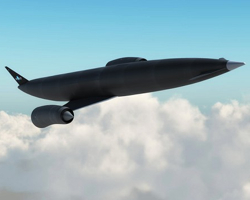 You can't accuse the developers of false modesty: They call their Sabre engine “the biggest breakthrough in propulsion since the jet engine.” If it manages to do everything that it's been designed to do, they could turn out to be right. The magic in the Sabre comes from a compressed helium cooling system that's able to cool air entering the engine from a searing 1000°C to an icy -150°C in 1/100 of a second. The -150°C operating temperature allows the Sabre to run with much more power than conventional jet engines without overheating. While predicted speeds are all theoretical at this point, the company estimates its engine would allow a properly designed aircraft to reach 2,000 mph. That's enough to reduce one of the most brutal long-haul routes, London to Sydney, to a comfortable 4.5 hours. Though Reaction Engines isn't the only company working on supersonic engines, its work is significant for another reason. In theory, it could allow passenger jets to go well beyond the 2,000 mph mark by leaving the atmosphere and traveling through space. Its research team has also suggested that the engines may be able to harvest oxygen from air at low altitudes in order to power higher speed flight. It's premature to speculate about how long it will take for the technology to find its way into the market. Once a production model is ready, the engine will face rigorous safety inspections and thousands of test flying hours before it can start paying passengers. Image: The Telegraph
You can't accuse the developers of false modesty: They call their Sabre engine “the biggest breakthrough in propulsion since the jet engine.” If it manages to do everything that it's been designed to do, they could turn out to be right. The magic in the Sabre comes from a compressed helium cooling system that's able to cool air entering the engine from a searing 1000°C to an icy -150°C in 1/100 of a second. The -150°C operating temperature allows the Sabre to run with much more power than conventional jet engines without overheating. While predicted speeds are all theoretical at this point, the company estimates its engine would allow a properly designed aircraft to reach 2,000 mph. That's enough to reduce one of the most brutal long-haul routes, London to Sydney, to a comfortable 4.5 hours. Though Reaction Engines isn't the only company working on supersonic engines, its work is significant for another reason. In theory, it could allow passenger jets to go well beyond the 2,000 mph mark by leaving the atmosphere and traveling through space. Its research team has also suggested that the engines may be able to harvest oxygen from air at low altitudes in order to power higher speed flight. It's premature to speculate about how long it will take for the technology to find its way into the market. Once a production model is ready, the engine will face rigorous safety inspections and thousands of test flying hours before it can start paying passengers. Image: The Telegraph New Engine Could Fly London to Sydney in 4.5 Hours
The British company Reaction Engines is working on an engine technology that could make air travel faster--much faster.  You can't accuse the developers of false modesty: They call their Sabre engine “the biggest breakthrough in propulsion since the jet engine.” If it manages to do everything that it's been designed to do, they could turn out to be right. The magic in the Sabre comes from a compressed helium cooling system that's able to cool air entering the engine from a searing 1000°C to an icy -150°C in 1/100 of a second. The -150°C operating temperature allows the Sabre to run with much more power than conventional jet engines without overheating. While predicted speeds are all theoretical at this point, the company estimates its engine would allow a properly designed aircraft to reach 2,000 mph. That's enough to reduce one of the most brutal long-haul routes, London to Sydney, to a comfortable 4.5 hours. Though Reaction Engines isn't the only company working on supersonic engines, its work is significant for another reason. In theory, it could allow passenger jets to go well beyond the 2,000 mph mark by leaving the atmosphere and traveling through space. Its research team has also suggested that the engines may be able to harvest oxygen from air at low altitudes in order to power higher speed flight. It's premature to speculate about how long it will take for the technology to find its way into the market. Once a production model is ready, the engine will face rigorous safety inspections and thousands of test flying hours before it can start paying passengers. Image: The Telegraph
You can't accuse the developers of false modesty: They call their Sabre engine “the biggest breakthrough in propulsion since the jet engine.” If it manages to do everything that it's been designed to do, they could turn out to be right. The magic in the Sabre comes from a compressed helium cooling system that's able to cool air entering the engine from a searing 1000°C to an icy -150°C in 1/100 of a second. The -150°C operating temperature allows the Sabre to run with much more power than conventional jet engines without overheating. While predicted speeds are all theoretical at this point, the company estimates its engine would allow a properly designed aircraft to reach 2,000 mph. That's enough to reduce one of the most brutal long-haul routes, London to Sydney, to a comfortable 4.5 hours. Though Reaction Engines isn't the only company working on supersonic engines, its work is significant for another reason. In theory, it could allow passenger jets to go well beyond the 2,000 mph mark by leaving the atmosphere and traveling through space. Its research team has also suggested that the engines may be able to harvest oxygen from air at low altitudes in order to power higher speed flight. It's premature to speculate about how long it will take for the technology to find its way into the market. Once a production model is ready, the engine will face rigorous safety inspections and thousands of test flying hours before it can start paying passengers. Image: The Telegraph
 You can't accuse the developers of false modesty: They call their Sabre engine “the biggest breakthrough in propulsion since the jet engine.” If it manages to do everything that it's been designed to do, they could turn out to be right. The magic in the Sabre comes from a compressed helium cooling system that's able to cool air entering the engine from a searing 1000°C to an icy -150°C in 1/100 of a second. The -150°C operating temperature allows the Sabre to run with much more power than conventional jet engines without overheating. While predicted speeds are all theoretical at this point, the company estimates its engine would allow a properly designed aircraft to reach 2,000 mph. That's enough to reduce one of the most brutal long-haul routes, London to Sydney, to a comfortable 4.5 hours. Though Reaction Engines isn't the only company working on supersonic engines, its work is significant for another reason. In theory, it could allow passenger jets to go well beyond the 2,000 mph mark by leaving the atmosphere and traveling through space. Its research team has also suggested that the engines may be able to harvest oxygen from air at low altitudes in order to power higher speed flight. It's premature to speculate about how long it will take for the technology to find its way into the market. Once a production model is ready, the engine will face rigorous safety inspections and thousands of test flying hours before it can start paying passengers. Image: The Telegraph
You can't accuse the developers of false modesty: They call their Sabre engine “the biggest breakthrough in propulsion since the jet engine.” If it manages to do everything that it's been designed to do, they could turn out to be right. The magic in the Sabre comes from a compressed helium cooling system that's able to cool air entering the engine from a searing 1000°C to an icy -150°C in 1/100 of a second. The -150°C operating temperature allows the Sabre to run with much more power than conventional jet engines without overheating. While predicted speeds are all theoretical at this point, the company estimates its engine would allow a properly designed aircraft to reach 2,000 mph. That's enough to reduce one of the most brutal long-haul routes, London to Sydney, to a comfortable 4.5 hours. Though Reaction Engines isn't the only company working on supersonic engines, its work is significant for another reason. In theory, it could allow passenger jets to go well beyond the 2,000 mph mark by leaving the atmosphere and traveling through space. Its research team has also suggested that the engines may be able to harvest oxygen from air at low altitudes in order to power higher speed flight. It's premature to speculate about how long it will take for the technology to find its way into the market. Once a production model is ready, the engine will face rigorous safety inspections and thousands of test flying hours before it can start paying passengers. Image: The Telegraph 
